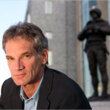Thunderstruck
(Libby/OverDrive eBook, Kindle)
Available Platforms
Description
A true story of love, murder, and the end of the world’s “great hush.”In Thunderstruck, Erik Larson tells the interwoven stories of two men—Hawley Crippen, a very unlikely murderer, and Guglielmo Marconi, the obsessive creator of a seemingly supernatural means of communication—whose lives intersect during one of the greatest criminal chases of all time.Set in Edwardian London and on the stormy coasts of Cornwall, Cape Cod, and Nova Scotia, Thunderstruck evokes the dynamism of those years when great shipping companies competed to build the biggest, fastest ocean liners; scientific advances dazzled the public with visions of a world transformed; and the rich outdid one another with ostentatious displays of wealth. Against this background, Marconi races against incredible odds and relentless skepticism to perfect his invention: the wireless, a prime catalyst for the emergence of the world we know today. Meanwhile, Crippen, “the kindest of men,” nearly commits the perfect murder.With his unparalleled narrative skills, Erik Larson guides us through a relentlessly suspenseful chase over the waters of the North Atlantic. Along the way, he tells of a sad and tragic love affair that was described on the front pages of newspapers around the world, a chief inspector who found himself strangely sympathetic to the killer and his lover, and a driven and compelling inventor who transformed the way we communicate.
More Details
Excerpt
Similar Titles From NoveList
Similar Authors From NoveList
Published Reviews
Booklist Review
In his follow-up to the enormously popular The Devil in the White City0 (2003), Larson sticks to a formula that works: pairing the story of a progressive development, in this case, wireless communication, with an exciting murder mystery set in England. The murderer in this book is Hawley Harvey Crippen, a mild_-mannered doctor and unlikely killer, who murdered his overbearing wife to be with his young lover. Crippen and Guglielmo Marconi take center stage in the book, and their stories gradually come together as Marconi's invention is integral in apprehending Crippen. Larson parallels the story of Crippen's unhappy marriage and eventual love affair with young Ethel Le Neve with Marconi's struggles to develop and perfect wireless technology in the face of adverse weather, envious fellow scientists, and everything in between. Marconi was both shrewd and tireless, even sacrificing personal happiness in pursuit of making wireless communication a reality. At the same time, pursued by his dead wife's friends, Crippen made a desperate bid for happiness by dressing his lover up as a boy and boarding the SS Montrose0 bound for Canada, never envisioning the massive pursuit he would set off. Larson has a knack for creating genuine suspense in his writing, and his latest is thoroughly enthralling. --Kristine Huntley Copyright 2006 Booklist
Publisher's Weekly Review
In this splendid, beautifully written followup to his blockbuster thriller, Devil in the White City, Erik Larson again unites the dual stories of two disparate men, one a genius and the other a killer. The genius is Guglielmo Marconi, inventor of wireless communication. The murderer is the notorious Englishman Dr. H.H. Crippen. Scientists had dreamed for centuries of capturing the power of lightning and sending electrical currents through the ether. Yes, the great cable strung across the floor of the Atlantic Ocean could send messages thousands of miles, but the holy grail was a device that could send wireless messages anywhere in the world. Late in the 19th century, Europe's most brilliant theoretical scientists raced to unlock the secret of wireless communication. Guglielmo Marconi, impatient, brash, relentless and in his early 20s, achieved the astonishing breakthrough in September 1895. His English detractors were incredulous. He was a foreigner and, even worse, an Italian! Marconi himself admitted that he was not a great scientist or theorist. Instead, he exemplified the Edisonian model of tedious, endless trial and error. Despite Marconi's achievements, it took a sensational murder to bring unprecedented worldwide attention to his invention. Dr. Hawley Harvey Crippen, a proper, unattractive little man with bulging, bespectacled eyes, possessed an impassioned, love-starved heart. An alchemist and peddler of preposterous patent medicines, he killed his wife, a woman Larson portrays lavishly as a gold-digging, selfish, stage-struck, flirtatious, inattentive, unfaithful clotheshorse. The hapless Crippen endured it all until he found the sympathetic Other Woman and true love. The "North London Cellar Murder" so captured the popular imagination in 1910 that people wrote plays and composed sheet music about it. It wasn't just what Crippen did, but how. How did he obtain the poison crystals, skin her and dispose of all those bones so neatly? The manhunt climaxed with a fantastic sea chase from Europe to Canada, not just by a pursuing vessel but also by invisible waves racing lightning-fast above the ocean. It seemed that all the world knew-except for the doctor and his lover, the prey of dozens of frenetic Marconi wireless transmissions. In addition to writing stylish portraits of all of his main characters, Larson populates his narrative with an irresistible supporting cast. He remains a master of the fact-filled vignette and humorous aside that propel the story forward. Thunderstruck triumphantly resurrects the spirit of another age, when one man's public genius linked the world, while another's private turmoil made him a symbol of the end of "the great hush" and the first victim of a new era when instant communication, now inescapable, conquered the world. 14-city tour. (Oct.) James L. Swanson's most recent book, Manhunt: The 12-Day Chase for Lincoln's Killer, was published by Morrow in February. (c) Copyright PWxyz, LLC. All rights reserved
School Library Journal Review
Adult/High School-Larson's page-turner juxtaposes scientific intrigue with a notorious murder in London at the turn of the 20th century. It alternates the story of Marconi's quest for the first wireless transatlantic communication amid scientific jealousies and controversies with the tale of a mild-mannered murderer caught as a result of the invention. The eccentric figures include the secretive Marconi and one of his rivals, physicist Oliver Lodge, who believed that he was first to make the discovery, but also insisted that the electromagnetic waves he studied were evidence of the paranormal. The parallel tale recounts the story of Dr. Hawley Harvey Crippen, accused of murdering his volatile, shrewish wife. As he and his unsuspecting lover attempted to escape in disguise to Quebec on a luxury ocean liner, a Scotland Yard detective chased them on a faster boat. Unbeknownst to the couple, the world followed the pursuit through wireless transmissions to newspapers on both sides of the Atlantic. A public that had been skeptical of this technology suddenly grasped its power. In an era when "wireless" has a whole new connotation, young adults interested in the history of scientific discovery will be enthralled with this fascinating account of Marconi and his colleagues' attempts to harness a new technology. And those who enjoy a good mystery will find the unraveling of Dr. Crippen's crime, complete with turn-of-the-century forensics, appealing to the CSI crowd. A thrilling read.-Pat Bangs, Fairfax County Public Library, VA (c) Copyright 2010. Library Journals LLC, a wholly owned subsidiary of Media Source, Inc. No redistribution permitted.
Library Journal Review
(See Prepub Alert, LJ 6/15/06).AAnn Kim (c) Copyright 2010. Library Journals LLC, a wholly owned subsidiary of Media Source, Inc. No redistribution permitted.
Kirkus Book Review
A murder that transfixed the world and the invention that made possible the chase for its perpetrator combine in this fitfully thrilling real-life mystery. Using the same formula that propelled Devil in the White City (2003), Larson pairs the story of a groundbreaking advance with a pulpy murder drama to limn the sociological particulars of its pre-WWI setting. While White City featured the Chicago World's Fair and America's first serial killer, this combines the fascinating case of Dr. Hawley Crippen with the much less gripping tale of Guglielmo Marconi's invention of radio. (Larson draws out the twin narratives for a long while before showing how they intersect.) Undeniably brilliant, Marconi came to fame at a young age, during a time when scientific discoveries held mass appeal and were demonstrated before awed crowds with circus-like theatricality. Marconi's radio sets, with their accompanying explosions of light and noise, were tailor-made for such showcases. By the early-20th century, however, the Italian was fighting with rival wireless companies to maintain his competitive edge. The event that would bring his invention back into the limelight was the first great crime story of the century. A mild-mannered doctor from Michigan who had married a tempestuously demanding actress and moved to London, Crippen became the eye of a media storm in 1910 when, after his wife's "disappearance" (he had buried her body in the basement), he set off with a younger woman on an ocean-liner bound for America. The ship's captain, who soon discerned the couple's identity, updated Scotland Yard (and the world) on the ship's progress--by wireless. The chase that ends this story makes up for some tedious early stretches regarding Marconi's business struggles. At times slow-going, but the riveting period detail and dramatic flair eventually render this tale an animated history lesson. Copyright ©Kirkus Reviews, used with permission.
Booklist Reviews
/*Starred Review*/ In his follow-up to the enormously popular The Devil in the White City(2003), Larson sticks to a formula that works: pairing the story of a progressive development, in this case, wireless communication, with an exciting murder mystery set in England. The murderer in this book is Hawley Harvey Crippen, a mild_-mannered doctor and unlikely killer, who murdered his overbearing wife to be with his young lover. Crippen and Guglielmo Marconi take center stage in the book, and their stories gradually come together as Marconi's invention is integral in apprehending Crippen. Larson parallels the story of Crippen's unhappy marriage and eventual love affair with young Ethel Le Neve with Marconi's struggles to develop and perfect wireless technology in the face of adverse weather, envious fellow scientists, and everything in between. Marconi was both shrewd and tireless, even sacrificing personal happiness in pursuit of making wireless communication a reality. At the same time, pursued by his dead wife's friends, Crippen made a desperate bid for happiness by dressing his lover up as a boy and boarding the SS Montrose bound for Canada, never envisioning the massive pursuit he would set off. Larson has a knack for creating genuine suspense in his writing, and his latest is thoroughly enthralling. ((Reviewed July 2006)) Copyright 2006 Booklist Reviews.
Library Journal Reviews
A milquetoast doctor murders his hen-pecking wife in Edwardian London, then glides off on an ocean liner with his mistress. He would have gotten away with it, too, but for Marconi's newly invented magic. With a 14-city tour; reading group guide. Copyright 2006 Reed Business Information.
Library Journal Reviews
With the glittering Edwardian age as backdrop, Larson (Devil in the White City ) has produced another masterpiece of popular history, again intertwining plots that prove grippingly to bear a relation to one another. Here, he gives us Guglielmo Marconi in a race against time and against other inventors to perfect his device for wireless communication. Meanwhile, Dr. Hawley Harvey Crippen, of London, has murdered his overbearing wife and is running with his mistress from Scotland Yard Chief Inspector Walter Dew. With enthralling narrative and vivid descriptions, Larson lays out Marconi's efforts and simultaneously provides the backstory of Dr. Crippen's unhappy marriage, his wife's murder, and his attempt to escape capture. While conjuring the drama of the chase and capture in Edwardian society, Larson isn't so rushed that he loses readers. With momentum building, the doctor, the inspector, and Marconi's wireless intersect in one fateful moment that fascinated millions and will fascinate a contemporary audience. While these topics have been covered before, Larson has done a marvelous job of bringing the distinct stories together in his own unique way. Simply fantastic! Highly recommended for all libraries, large and small. [See Prepub Alert, LJ 6/15/06.] Gena Moore, Central Piedmond Community Coll. Lib, NC
[Page 102]. Copyright 2006 Reed Business Information.School Library Journal Reviews
Adult/High School Larson's page-turner juxtaposes scientific intrigue with a notorious murder in London at the turn of the 20th century. It alternates the story of Marconi's quest for the first wireless transatlantic communication amid scientific jealousies and controversies with the tale of a mild-mannered murderer caught as a result of the invention. The eccentric figures include the secretive Marconi and one of his rivals, physicist Oliver Lodge, who believed that he was first to make the discovery, but also insisted that the electromagnetic waves he studied were evidence of the paranormal. The parallel tale recounts the story of Dr. Hawley Harvey Crippen, accused of murdering his volatile, shrewish wife. As he and his unsuspecting lover attempted to escape in disguise to Quebec on a luxury ocean liner, a Scotland Yard detective chased them on a faster boat. Unbeknownst to the couple, the world followed the pursuit through wireless transmissions to newspapers on both sides of the Atlantic. A public that had been skeptical of this technology suddenly grasped its power. In an era when wireless has a whole new connotation, young adults interested in the history of scientific discovery will be enthralled with this fascinating account of Marconi and his colleagues' attempts to harness a new technology. And those who enjoy a good mystery will find the unraveling of Dr. Crippen's crime, complete with turn-of-the-century forensics, appealing to the CSI crowd. A thrilling read.Pat Bangs, Fairfax County Public Library, VA
[Page 191]. Copyright 2006 Reed Business Information.Reviews from GoodReads
Citations
Larson, E. (2006). Thunderstruck . Crown.
Chicago / Turabian - Author Date Citation, 17th Edition (style guide)Larson, Erik. 2006. Thunderstruck. Crown.
Chicago / Turabian - Humanities (Notes and Bibliography) Citation, 17th Edition (style guide)Larson, Erik. Thunderstruck Crown, 2006.
Harvard Citation (style guide)Larson, E. (2006). Thunderstruck. Crown.
MLA Citation, 9th Edition (style guide)Larson, Erik. Thunderstruck Crown, 2006.
Copy Details
| Collection | Owned | Available | Number of Holds |
|---|---|---|---|
| Libby | 3 | 0 | 0 |




































